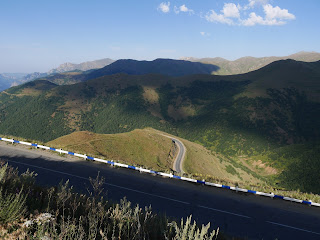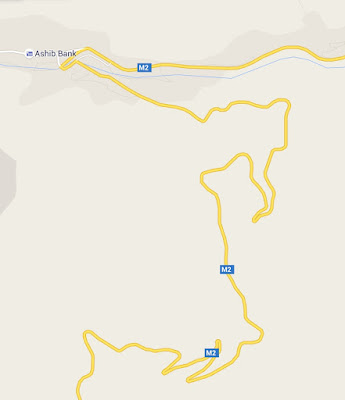Wednesday was an important Shia holiday, the Feast of the Martyrdom of Ali, the prophet’s cousin and son-in-law, whose murder triggered the schism that split Islam into Sunni and Shia branches. As a result, all the tourist destinations were closed, and so I took an obligatory break from my frenetic sight-seeing schedule and spent much of the day just hanging out at my hotel.
I did take a couple of long walks around Tehran, and checked out the Tehran Metro. There are four lines lines in the metro system: Line 1, Line 2, Line 4, and Line 5. No doubt Israel has something to do with the missing Line 3. It was unremarkable in many ways; vaguely reminiscent of Montréal, and like Cairo, features ”women only” carriages, although it is doubtful Iranian men have the same difficulty keeping their hands to themselves the way Egyptian men do. One unique feature I particularly liked was the train status board. Different Metro systems have different ways of keeping you informed about the next train — in Stockholm and London, there are information screens that tell you how long to the next few trains and their destination. In Warsaw, where trains run at fixed intervals, a counter starts when a train leaves the station, so when it reaches 4 minutes during peak hours, you know another should be arriving momentarily. Here in Tehran, there are graphic signs showing where the trains are — red dots indicating they are in a station, and yellow arrows showing when they are travelling between stations.
 Where's my train?
Where's my train?There are many things I have come to like about Iran; I have to admit that the food is not one of them, although you might not guess that from seeing how my waistline has expanded since I have arrived. One reason is that there are not a lot of dining options in Tehran or anywhere else; this may in part be because of Iranians' preference for entertaining at home, where they can escape the social strictures imposed by mullahs and literally let their hair down.
That evening, I decided to get a break from the endless rice and kabab and seek out one of Tehran’s few fine dining venues, the nearby Baharestan Grand Restaurant. I arrived shortly before dusk (none of the restaurants of course would be serving until the end of the fast) to find the place brightly lit, the tables set, and plates of salad, bread, dates and nuts covered with plastic wrap already set out and waiting for the end of the fast. Dozens of people milled around, but nobody seemed to be charge, or even to speak English. Finally one charming young woman offered to assist in English, but she informed me that the restaurant was fully booked for the evening. But then she asked how many persons, and I explained that I was alone. ”Just you?” she asked, ”OK, no problem,” and she led me to a place at a round table.
I waited for a bit as they brought more food to each of the tables, including a steaming tureen of soup that looked and smelled fantastic. When the fast finally ended, I was joined by the young woman who helped me earlier (who introduced herself as Mehrnoush), and a fit-looking gentleman who turned out to be her brother. After speaking with them a few minutes I slowly realised that the brother — an apparently well to-do anæsthesiologist — had actually booked the entire restaurant for the evening for a private event with his very large extended family, and I just either charmed or buffaloed my way into this gathering, depending on your perspective on such things.
First priority for Mehrnoush, her mother and sister was determining my marital status and economic potential. They accomplished by asking a series of subtle, yet probing, questions such as ”are you single?” and ”do you earn a lot of money?”. Her Mom was visibly disappointed when I told her I was engaged, and she was not entirely convinced of this until I produced a photo of MJ, whom she nonetheless pronounced to be ”very beautiful.”
Second order of business was giving all the young cousins of the clan the opportunity to practice their English with me, which many of them did. Some were shy and hesitant, but in particular one charismatic 11 year-old spoke with much poise and confidence, and learning that I was from America, declared that ”I think your country is sensational!” Apparently, this was one of his favourite adjectives, as he also used it to describe the Chelsea Football Club, BMW automobiles, the iPhone, the Iranian Volleyball team and the sport of volleyball in general, and the dessert we were eating. I didn’t ask his views on the Greek economy.
Next came all the men of the clan, who each in turn stopped by my table to show off babies, ask my opinions on Football and Volleyball, complain about the sanctions and politicians, and tell me in which state they had relatives in the USA (it was always California).
Finally, the ladies — the charming, black-clad Iranian ladies — who arrived in a gaggle led by Mehrnoush’s mom and ancient Auntie, and who asked far more pointed and intelligent questions than the men did — what did I think of the nuclear negotiations? Did I like Obama? (they didn’t) Did I like Khomeni? (they liked him even less). How old was I? (I referred the question to my attorneys).
Undoubtedly that evening will be one of my best memories of Iran — they were all so charming, so welcoming, so friendly. It took me a full half-hour to take my leave, shaking hands with the men, bowing to the ladies, high-fiving the kids. Mehrnoush gave me her number and told me to call if I needed any help. I got back to the hotel to find Mehdi and one of the hotel staff having a cup of tea in the front garden and joined them for a bit before calling it a night.
Next day, it was back to sight-seeing with a visit to the Golestan Palace, a Qajar-dynasty complex of buildings arranged around a landscaped courtyard. Near the entrance was the marble throne where the Shahs of Iran have been crowned for the past 300 years or so (the Qajars moved the capital to the then-village of Tehran from Isfahan in the early 18th century). Even before this visit I was starting to get opulence burn-out — and this sent me over the edge: yes, very nice, the interior of this palace is marble. Ooh, this one is covered in silver and mirrors. Ah, here’s a gilt one, and this one is all intricately inlaid woods. Somewhat more interesting were the displays of gifts that the Shahs had received from foreign dignitaries and potentates over the centuries, including two Farsi typewriters from the USA, and a badge of the Royal Order of Kamehameha I from one of the Kings of Hawaii’i.
 The Qajars liked things sparkly
The Qajars liked things sparklyAfter the palace, we headed to the nearby Grand Bazaar, which is reminiscent of the Grand Bazaar in Istanbul. Like most bazaars, it was organised into different sections with all shops of one type clustered together — carpets, kitchenware, housewares, electronics, office supplies, gold, spices, etc. A scrum of shouting, gesticulating men outside one of the entrances turned out to the city’s foreign currency market. We also made a short visit to the nearby Imam Khomeni mosque before calling it a day.
Friday was another day of enforced relaxation, as all government-run facilities, including museums, were closed to encourage everyone to attend anti-Israeli demonstrations for "Quds Day". We didn’t know this, however, when we set out this morning for Tajrish, in northern Tehran at the last stop on Metro line 1 in order to visit the Sa’d Abad complex, where two more palaces and various museums, etc. are located. Tajrish itself had a pleasant, village-like atmosphere, with lots of green-grocers selling impossibly fresh, beautiful looking fruit, a small but lovely bazaar, a wonderful bakery, and temperatures a few degrees cooler than central Tehran. Above it looms Mt. Tochal, a 3933 metre peak that hosts one of Iran’s most popular ski areas.
After travelling 15 stops by metro, we took a shared taxi to the entrance gate of the complex to find it closed, so we retraced our steps and ended up back at the hotel in time for lunch. Afterwards, I took a short nap, and then decided to visit the infamous ”Den of American Espionage,” formerly known as the Embassy of the United States of America to the Imperial State of Iran. I had been warned to be discreet and low-key, especially when taking photographs, but I arrived to find the place deserted and the anti-American graffiti faded and peeling. Immediately next to the ”Down With USA” graffito was a small convenience store selling ice-cold Pepsi and Coca-Cola, amongst other refreshments. I guess radical Islamists need that ”pause that refreshes” now and then, just like everyone else. I walked the entire length of perimeter fence and encountered no one except a couple of ladies strolling along. At the main entrance, the Great Seal of the United States had been obviously defaced but was mostly still legible.
 A somewhat disappointing attempt at defacement – a bit of spattered blood and black spray paint would have been much more effective
A somewhat disappointing attempt at defacement – a bit of spattered blood and black spray paint would have been much more effectiveI couldn’t avoid feeling cheated somehow — I came looking for wild-eyed radicals spewing hate-filled, anti-American invective and instead just found a quiet Tehran neighbourhood. Maybe I should try South Carolina
?
 And when is the last time anyone did any maintenance on this graffito?
And when is the last time anyone did any maintenance on this graffito?In the meantime, I learned from the TNT web site that Iranian customs cleared my new starter motor, and it presumably would soon be on its way to Shiraz. I talked to my brother and learned my Dad had pulled back from brink and had a couple of relatively good days, with his blood pressure back up from critical levels, although he still could go at any time. My ticket back to the USA from Yerevan is booked. Nothing much more I can do at this point but continue praying.
Blogndog
11 July 2015
Tehran























